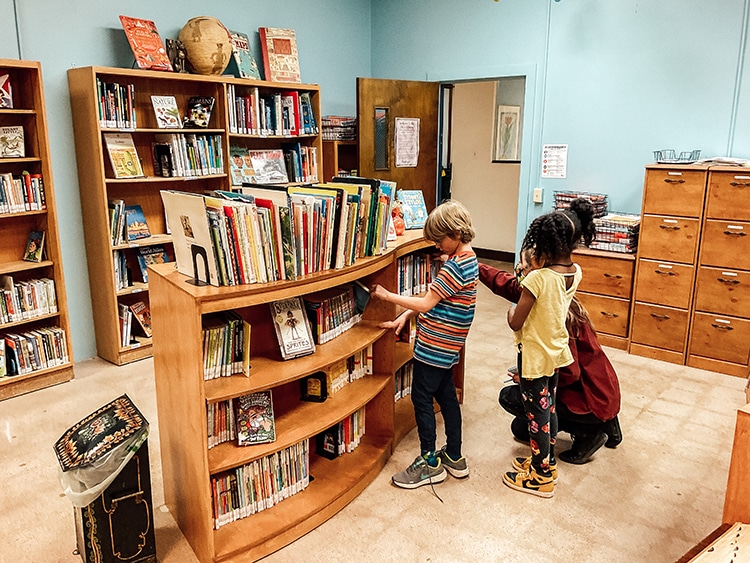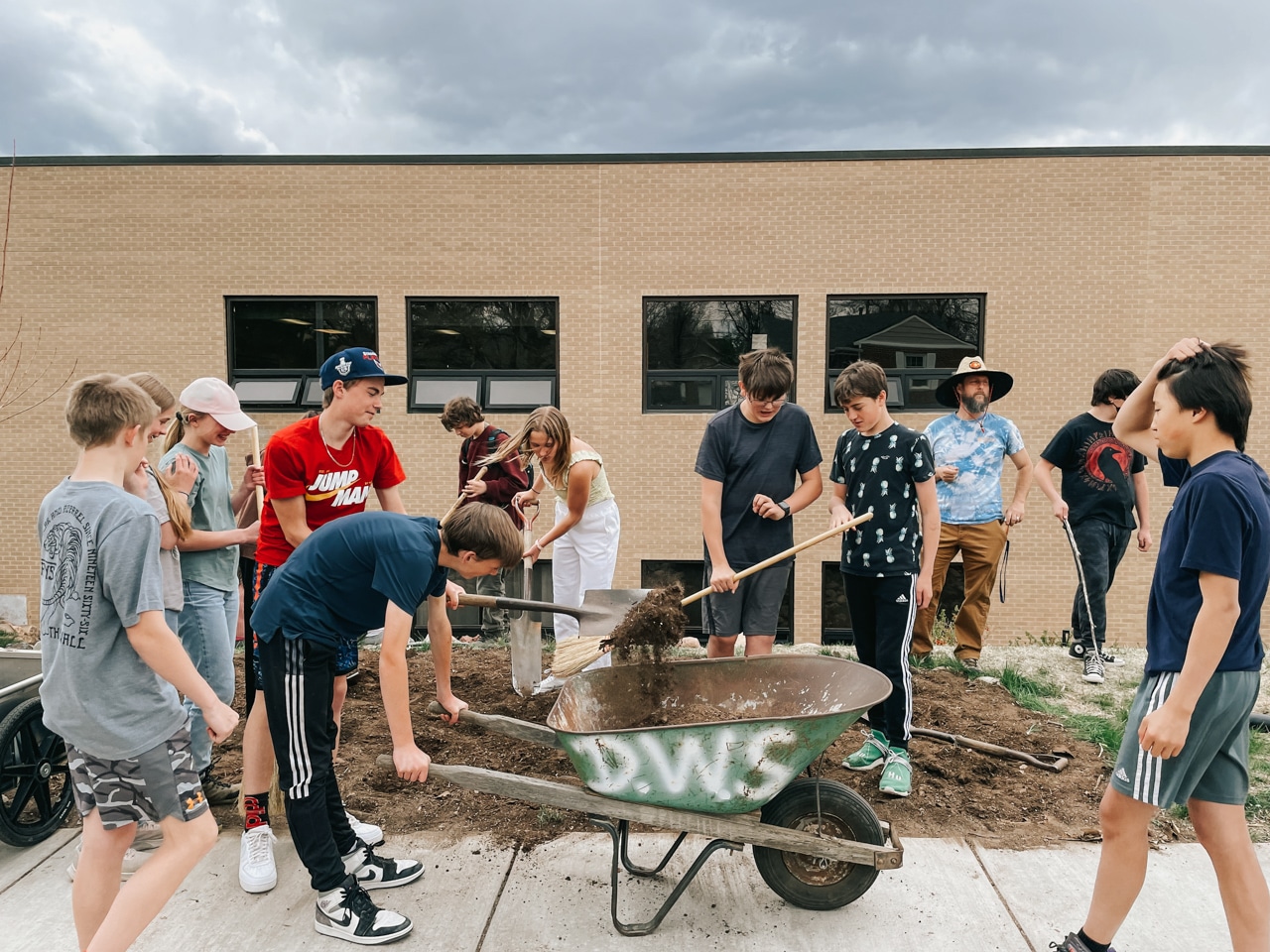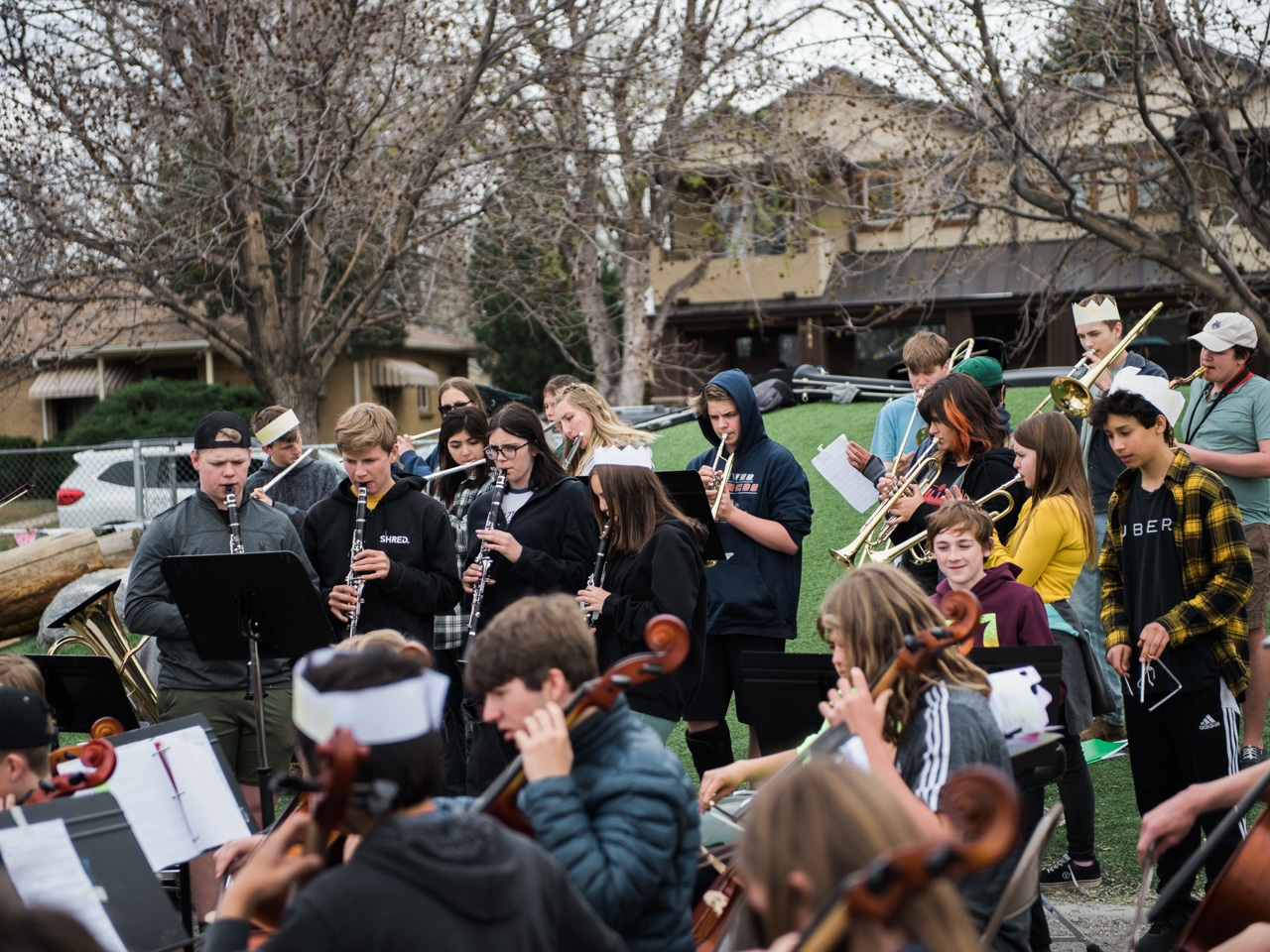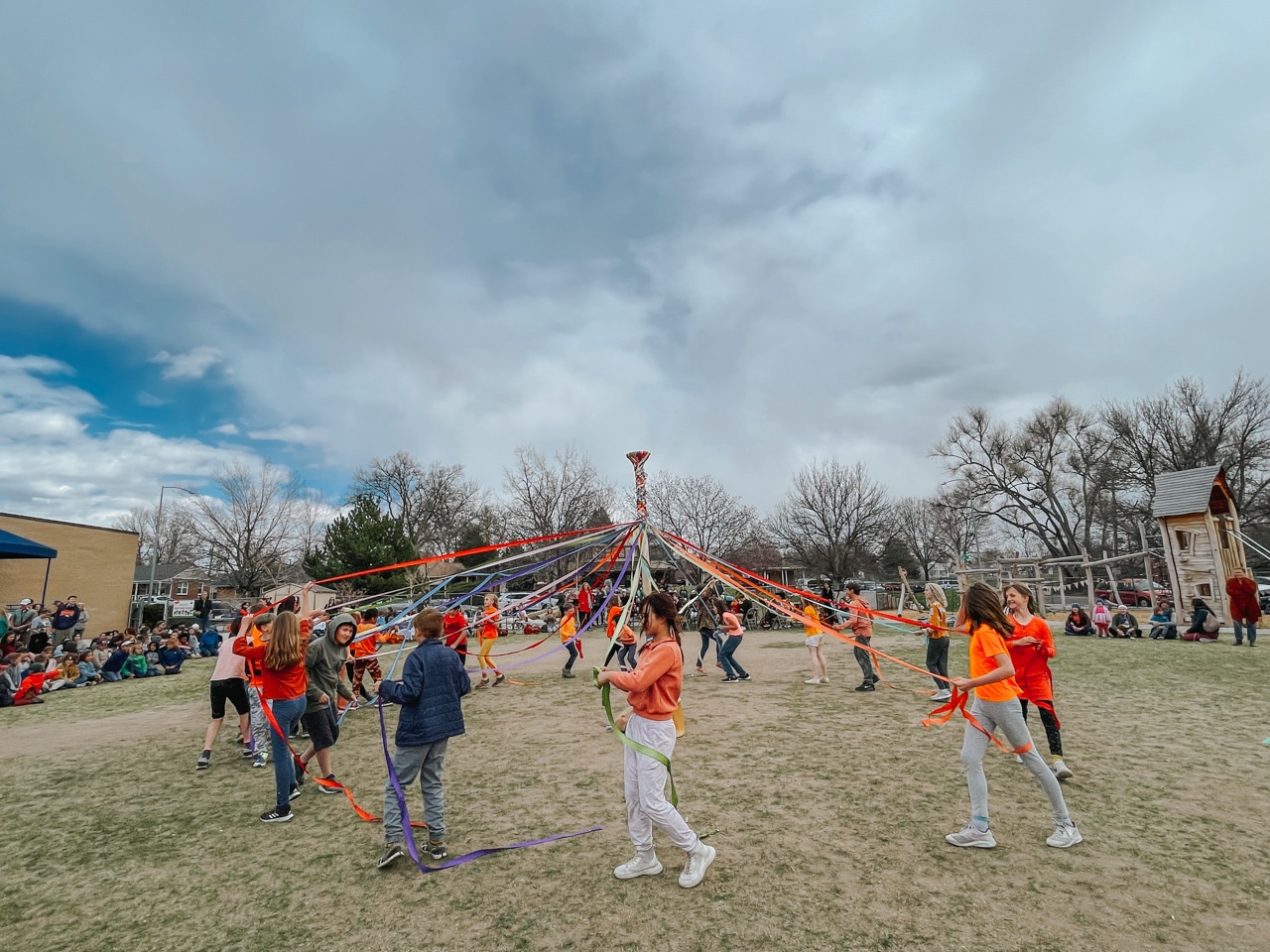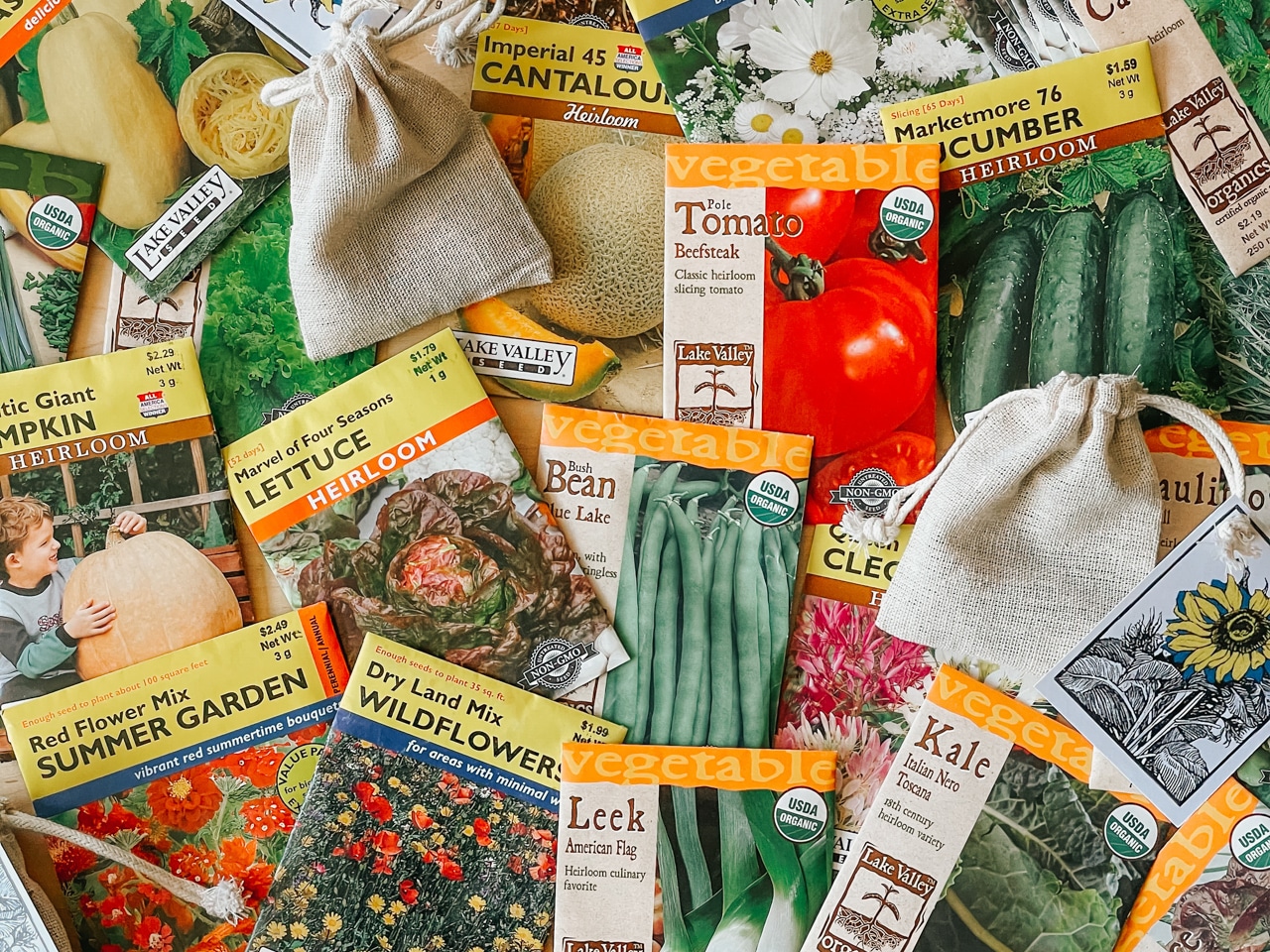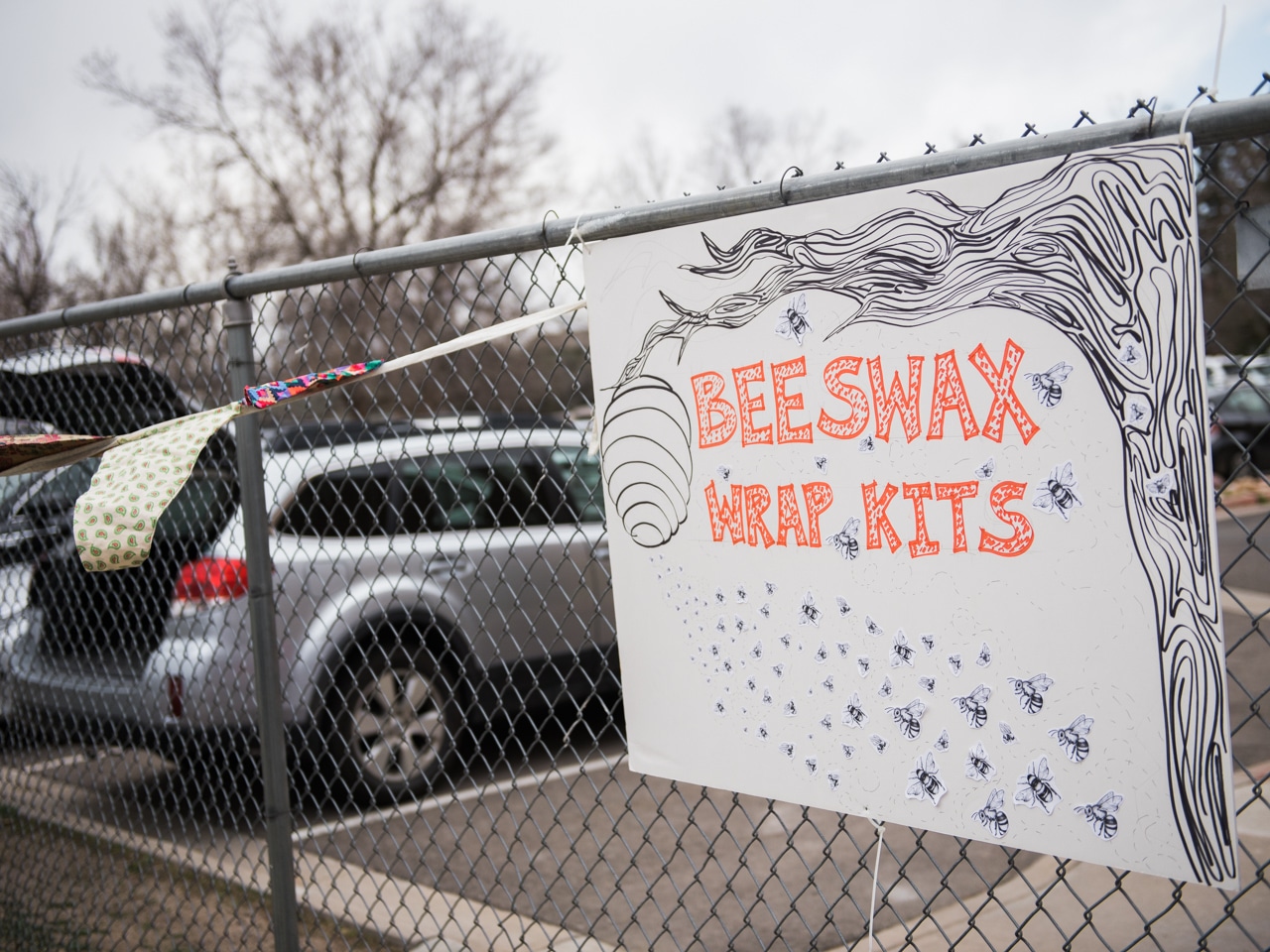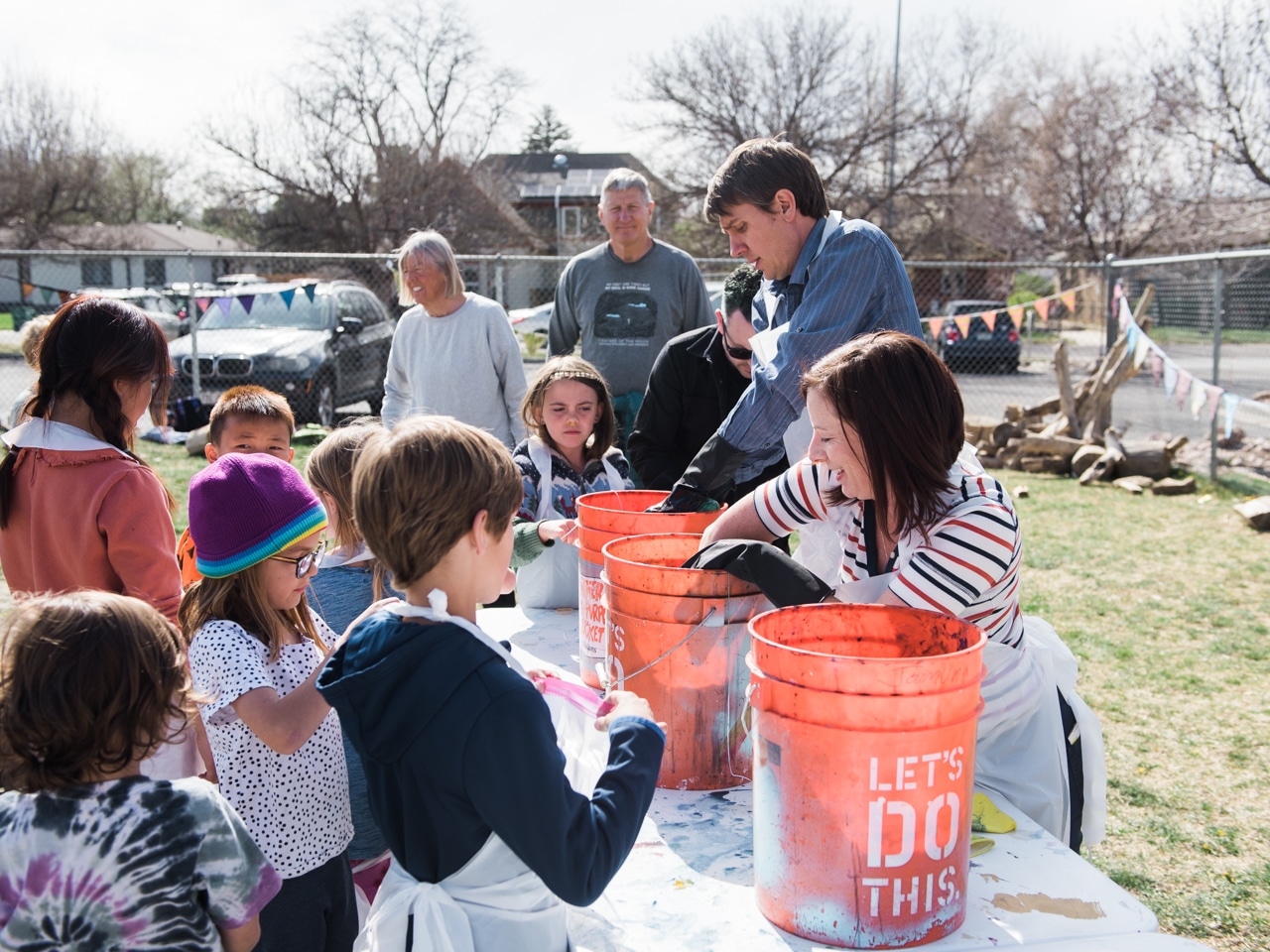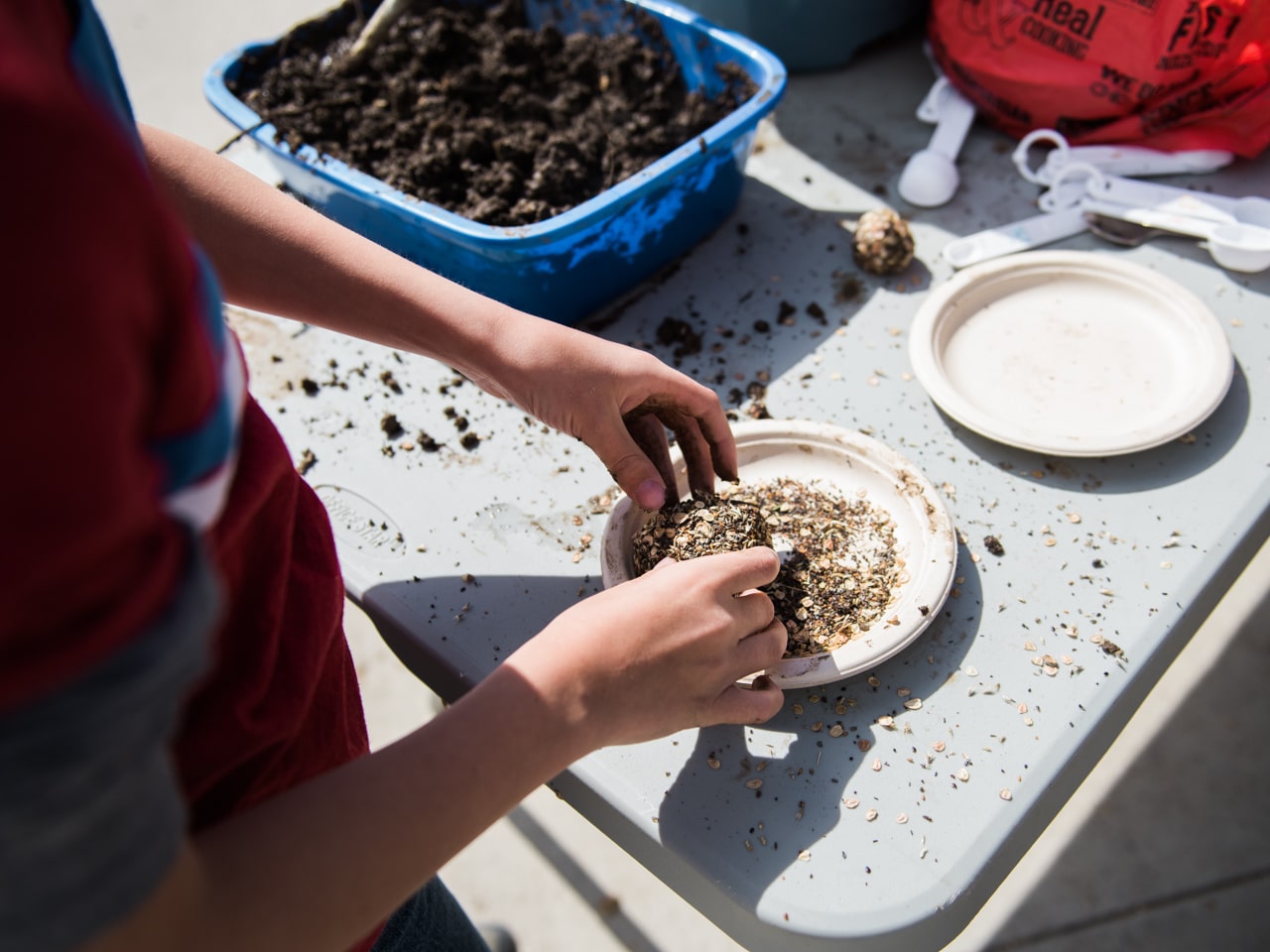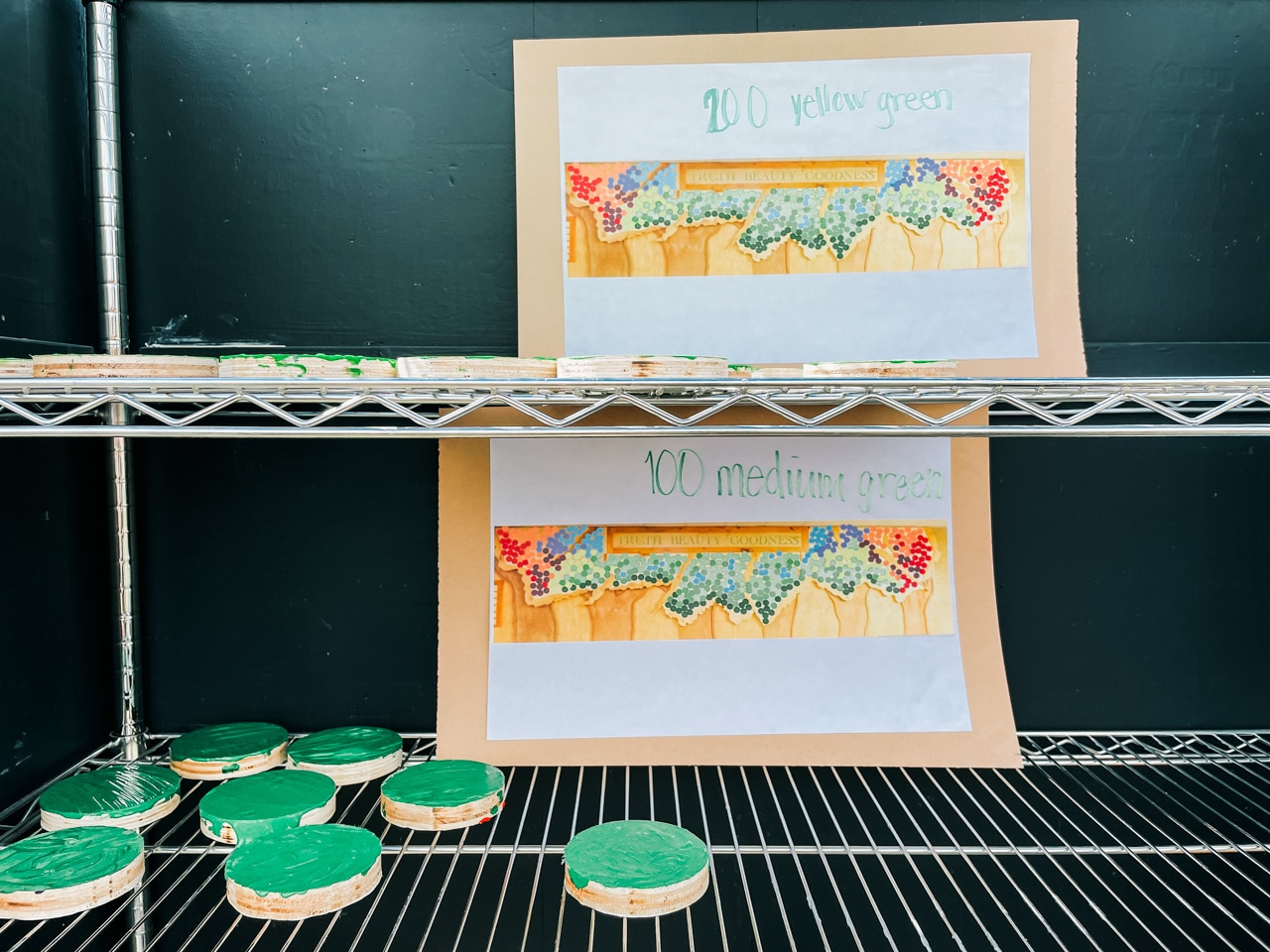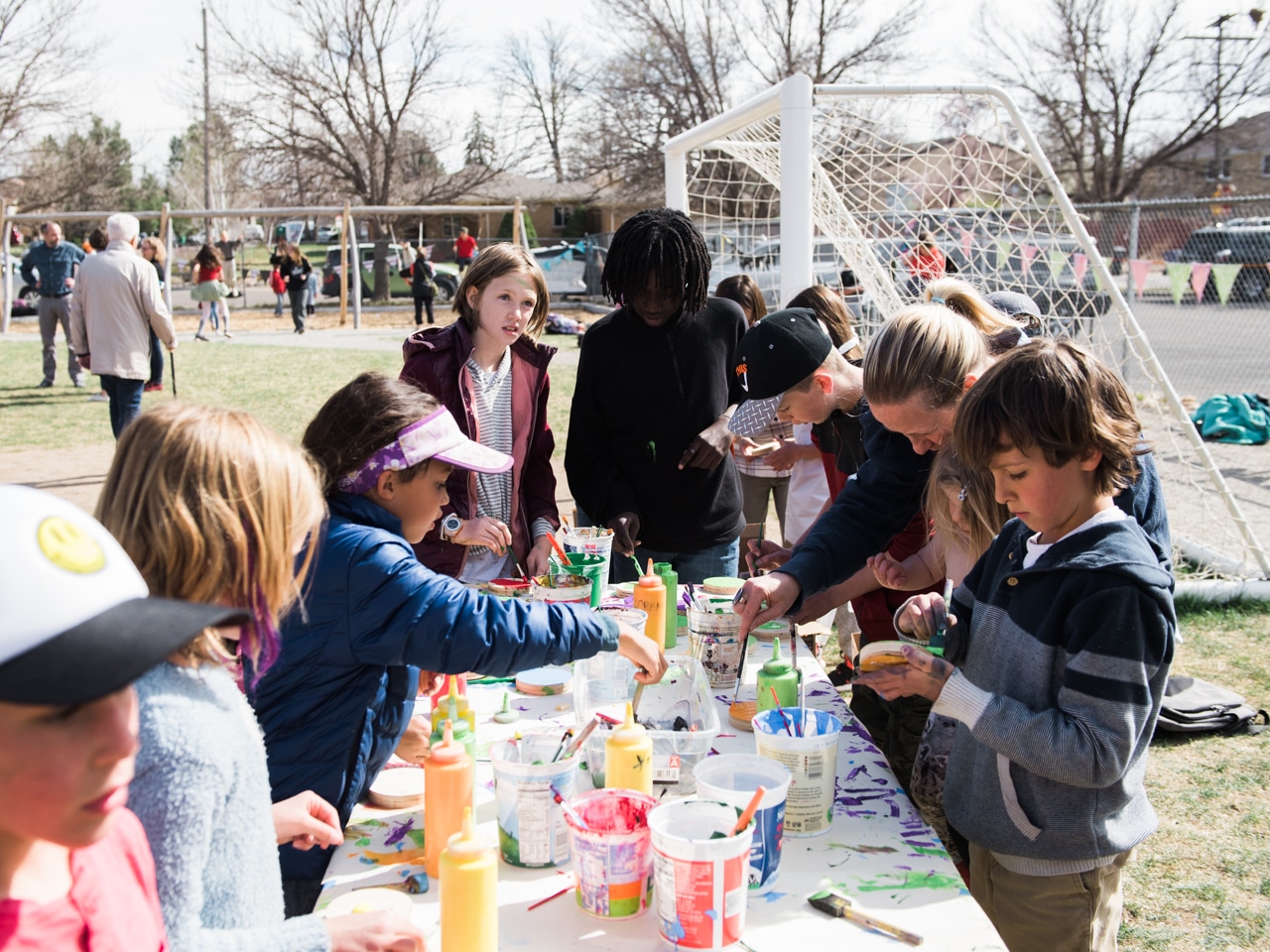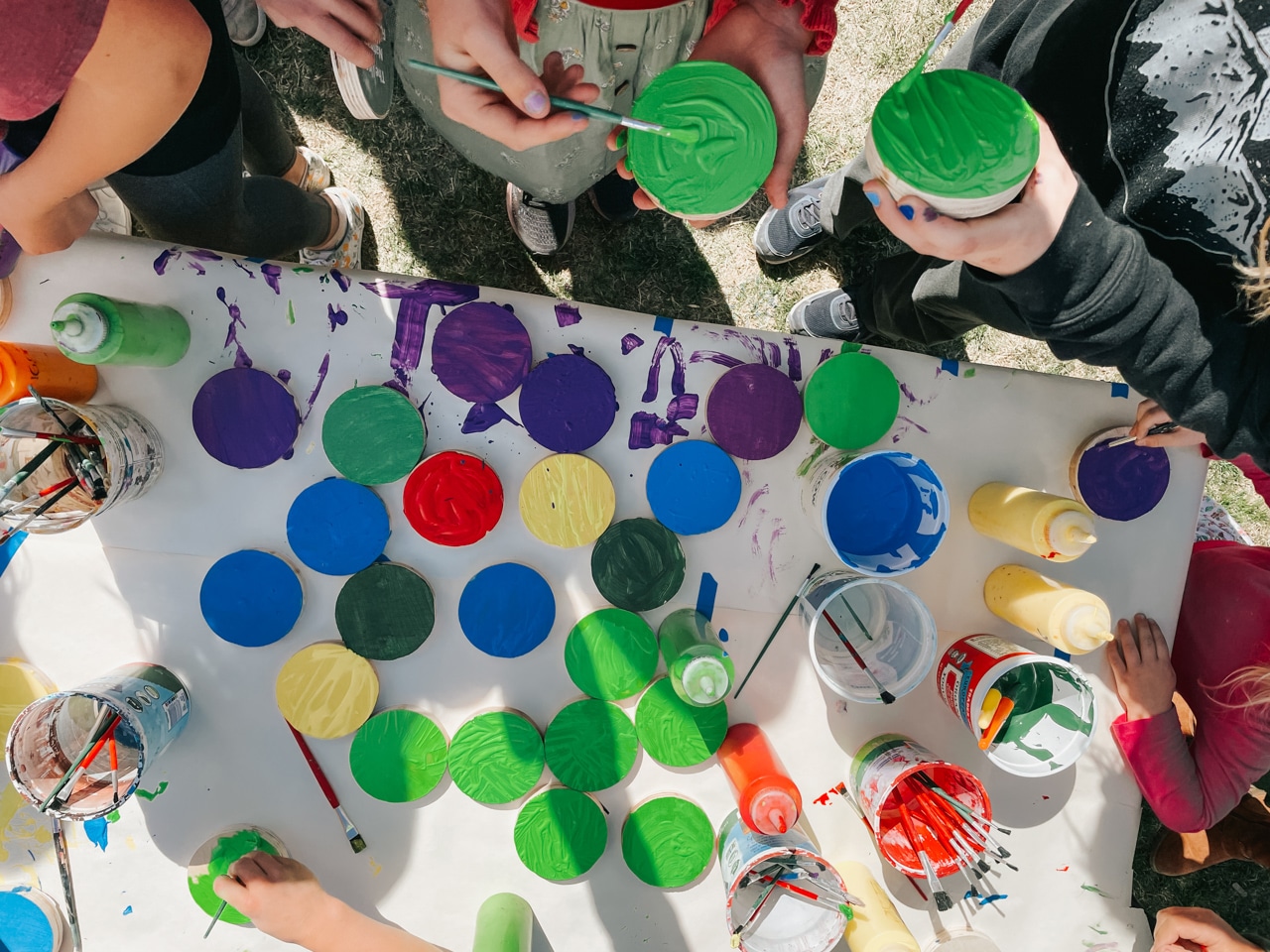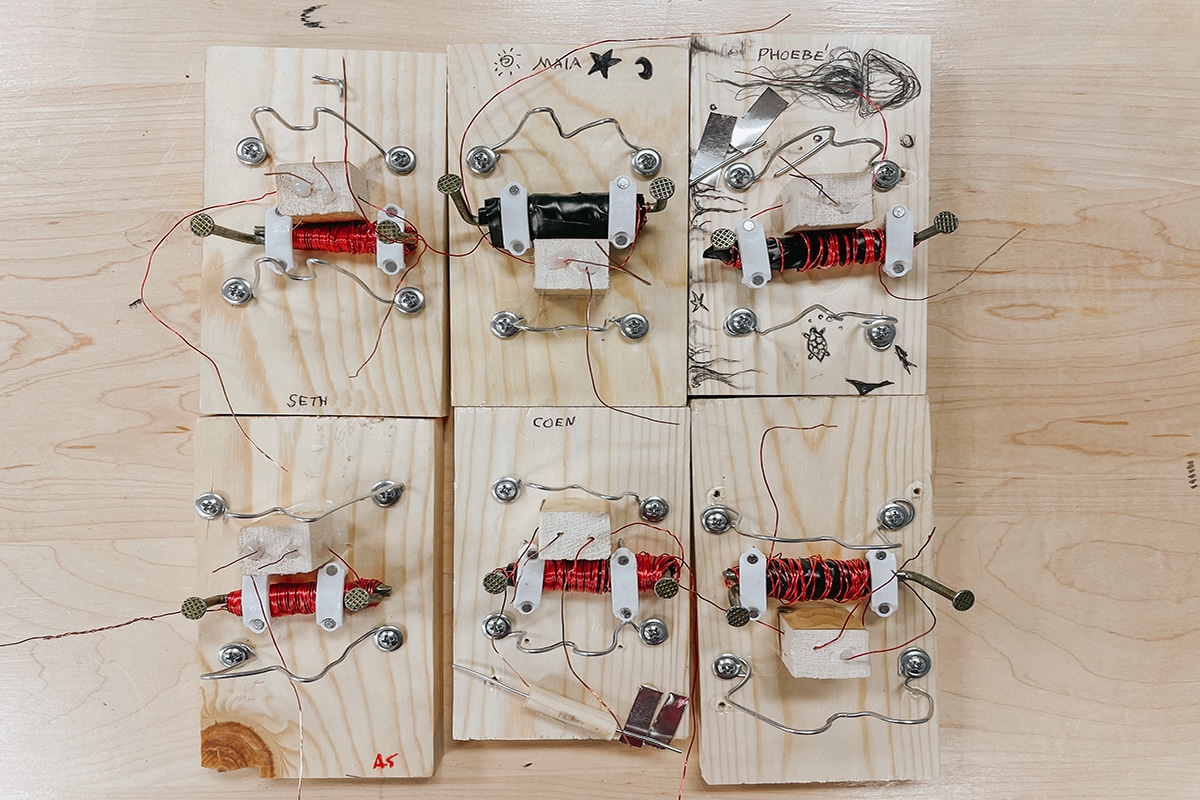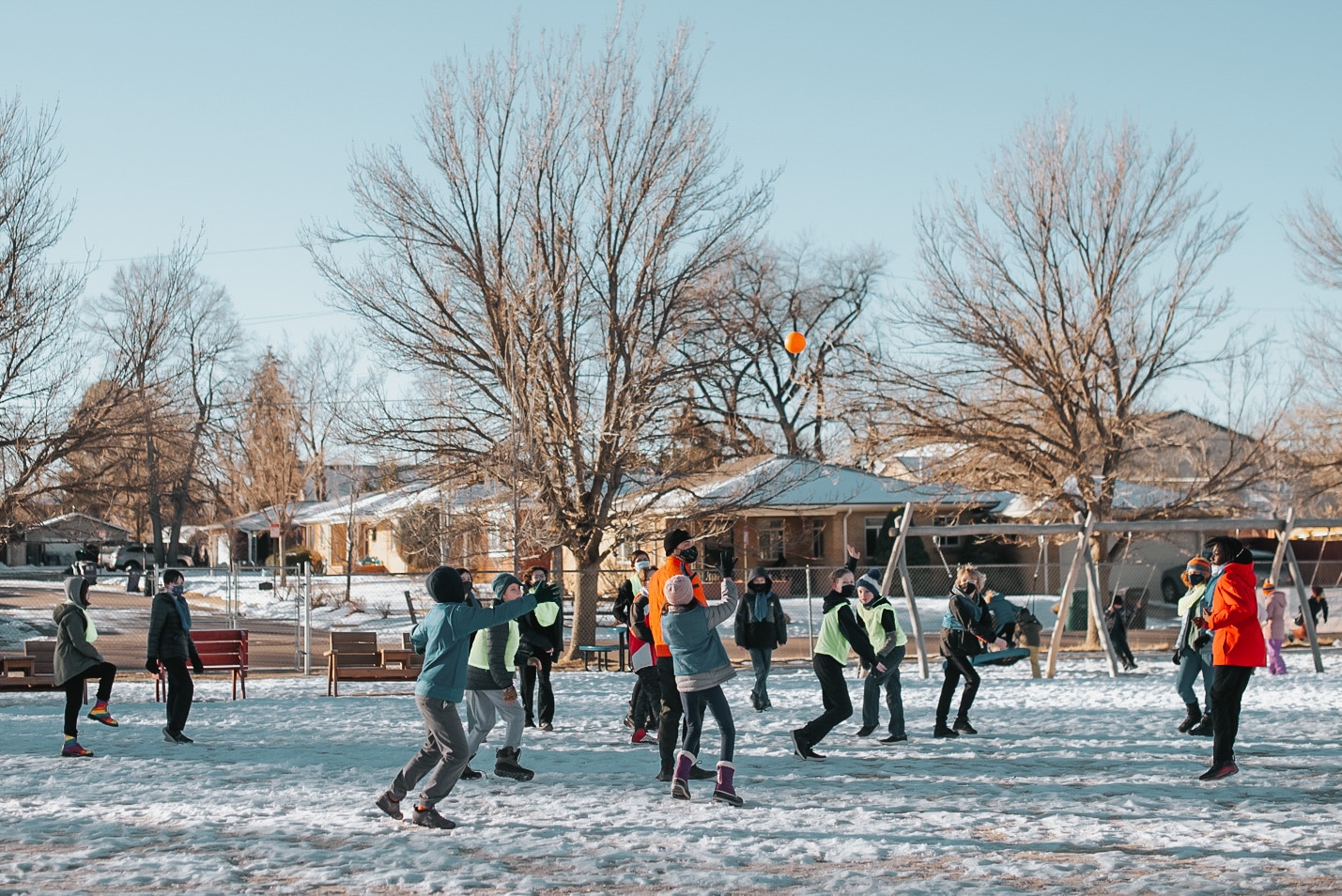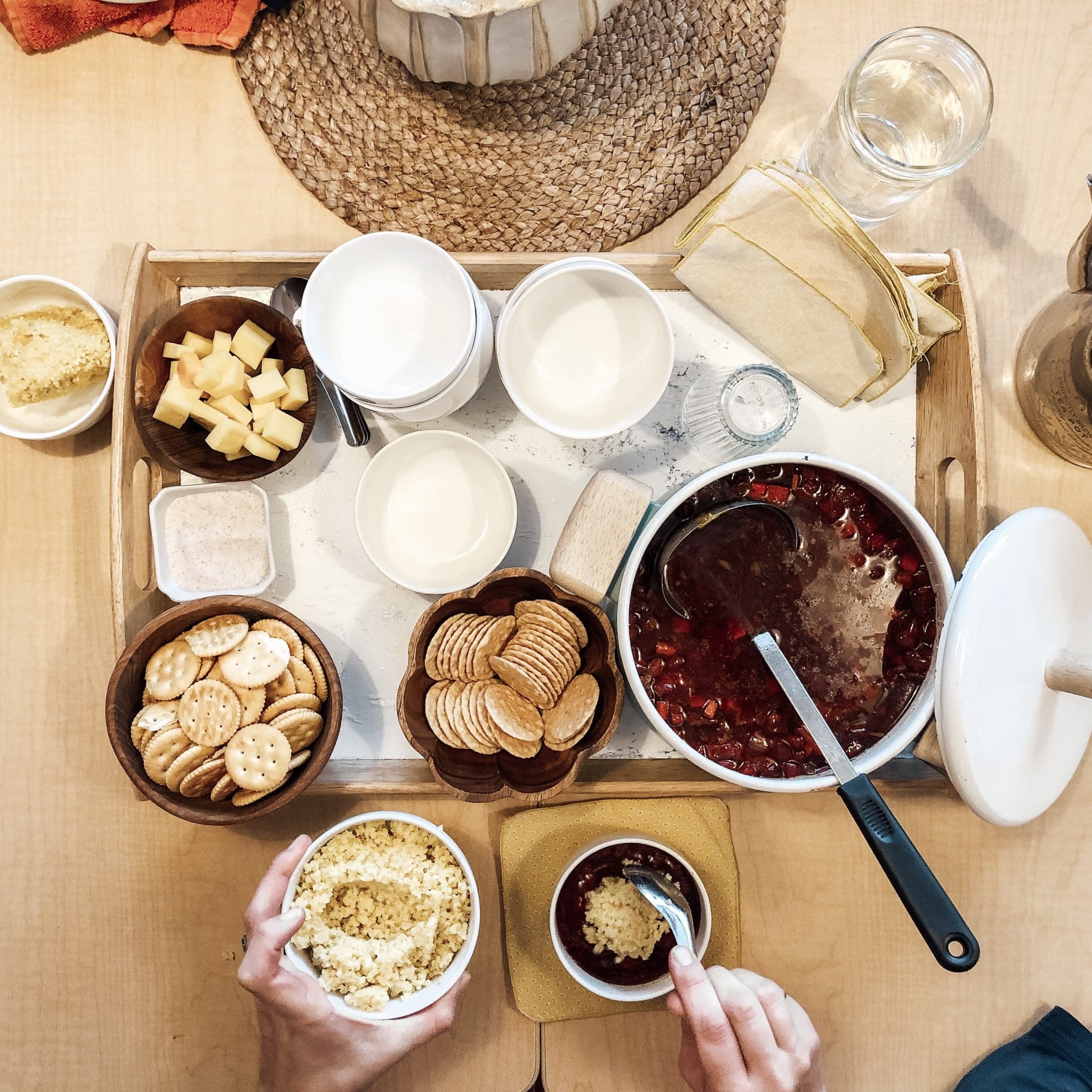Green Pea and Mint Pesto Recipe
With the abundance of fresh mint growing in our gardens this time of year, we thought we would share a recipe that our high school students made in nutrition class. It highlights the antioxidant and antimicrobial-rich polyphenols of common herbs such as mint, and was well loved by all! Enjoy.
Ingredients:
- 1 cup fresh English peas
- 1/2 cup packed fresh mint
- 1/2 cup fresh packed sprouts/microgreens
- 1-2 cloves garlic
- 1/2 lemon juiced
- 1/2 cup or more olive oil
- salt to taste
Directions:
- In a food processor, finely chop the peas, mint, garlic, and sprouts.
- Add the salt, lemon juice, and olive oil and blend till smooth. Serve on crackers or vegetable chips
Many thanks to Carla Abate for sharing. Carla is a family wellness educator and advocate for the importance of nutrition during the perinatal stages. She is a certified master nutrition therapist (MNT) and postpartum doula. Her experience with pregnancy and entry into motherhood helped inspire what she does today. With motherhood came self-growth, inspiration, and courage. It also brought great challenge forcing her to dive deep into her own wellness journey. Today, it’s Carla‘s mission to help other mothers (and their families) flourish throughout pregnancy and well beyond.
Find out more at rebelrootsnutrition.com or on instagram @rebelrootsnutrition or contact Carla directly at carla@rebelrootsnutrition.com
Summer Reading Lists
The adventures that await with the turn of a page. This is the beauty of a new book - a chance to journey to faraway places, different times, and fresh experiences to feed those imaginations. For all those summer days ahead swinging in a hammock or resting under the shade of a tree, we wanted to share suggested reading lists in case you are searching for new ideas!
The Library Committee and class teachers curated the lists below by rising grade level - so...spread out a blanket, relax, sip a lemonade, and read!
2nd Grade
3rd Grade
4th Grade
5th Grade
6th Grade
7th Grade
8th Grade
The Festival of Life Renewed
The Denver Waldorf School is a community that embraces the festival life. We come together to celebrate the turning of the seasons, to find joy and meaning in diverse cultural traditions, and to strengthen our connections to each other and to this world.
This past week, we came together to celebrate The Festival of Life Renewed. Springtime represents the promise of life renewed, as plant and animal life emerges from winter’s chill. Spring’s flowers, like our colorful tulips, open their petals to the sun’s warmth. In a way, our community does the same: opening ourselves to the hope and promise of a new season filled with light. We celebrate both a rebirth of ourselves and of the natural world.
To cultivate our connection to nature around us, we spent the afternoon in service together – whether it was preparing the school gardens, or picking up trash from our surrounding parks, or planting flowers in our pots. Working in community with our hands in the earth, we each had our part in contributing to the beauty around us – with thanks and appreciation for nature’s many gifts.
Our entire student body then treated our community to a performance of Finlandia – coming together in harmony with our voices, string, percussion, wind and brass instruments. As is tradition, our fourth graders then danced around the Maypole – weaving and laughing along every step, all the while showing how our collective contributions can come together!
The celebration continued with earth-focused activities to celebrate spring’s arrival. Thanks to Parent Council and the many helping hands, there were stations for for tie-dyeing t-shirts, painting repurposed pucks that will soon beautify our entryway, making seed bombs, and giveaways for kits to make reusable beeswax wraps as well as seeds to start those gardens.
We are so grateful for our community that cherishes the gifts of the Earth and of one another! May we look forward to all of the growth of the season ahead, together.
Science in the Waldorf Curriculum
“How can I be the person who potentially takes this field forward?” That is the question that DWS high school physics and mathematics teacher, Adam Newman, wants his students to ponder.
This question arises from years of thoughtful scientific study, beginning in kindergarten and continuing through elementary school, middle school, and high school. A developmentally appropriate scientific curriculum — interwoven with history, arts, and mathematics — empowers our students to think critically, observe carefully, and find their place in a dynamic world.
The Scientific Journey from Kindergarten Through High School
Our education in science begins with our youngest in kindergarten. Quite simply, the children observe and experience the world in a way that develops foundational scientific skills.
In the early years, nature walks allow young children to hone their skills of observation. In the springtime, they may see tulips pushing through the soil and opening their beautiful colors to the sky. They may hear a mother robin chirping to her babies in the bough of a spruce tree. They may feel the soil, warm and soft underneath their little toes.
In addition to nature walks, kindergartners come to intuitively understand mechanical processes by simply playing on a teeter totter or kicking their legs out on a swing. During story time, they become engrossed in stories of nature, all the while building a foundation on which later scientific training will rest.
This foundation continues into the early grades. By third grade, students learn ecology by studying how people work in the world — in this case, how farmers serve as stewards of the earth. The youthful eagerness to work and to learn about the world spark an interest in natural processes.
In fourth grade, students directly study the living world through explorations of the human and animal kingdom. The students employ the arts to further their study of morphology. As long time DWS teacher Tom Clark says, “The arts are the good friends of science. Together, they help us understand reality.” The study of morphology encourages students to perceive reality through truth and observation.
In the last year of elementary school, fifth graders study the living world through botany. They carefully draw plants, further training their powers of observation. To truly understand a natural system, one must first be able to observe and reproduce its critical elements.
In middle school, the science curriculum is tailored to the students’ awakening intellects through the study of chemistry, physics, and physiology. They learn experientially through their senses. The principle theme, as Mr. Clark explains, is: “without jumping to a conclusion, what exactly did you see?” From experiment to concept, students learn through hands-on experience and carefully record their observations.
In seventh grade, the students explore mechanics, learning how simple machines work. They work with levers to grasp how a relatively small amount of force can be applied to lift, for example, the back end of a teacher’s car!
With this solid understanding of basic machinery, eighth graders are challenged to understand the technology that impacts our lives. From stereo headphones to motors to internal combustion and jet engines, our Waldorf students gain a working knowledge of the forces at work in our modern world.
By the time a Waldorf student enters high school, they have already developed keen powers of observation. The focus in high school centers around the capacity to think scientifically across various disciplines — including chemistry, biology, and physics.
Unlike some high schools that may teach biology one year and chemistry the next, DWS integrates the major scientific disciplines into each of the four years through their block system. Consequently, our graduates will have taken chemistry, for example, in all four years—not just one.
In ninth grade, students are “very much into the what” of the world, as explained by Nancy Taylor, DWS high school science teacher for the Life Sciences (biology and chemistry). The study of anatomy taps into this natural curiosity during the ninth grade year.
In tenth grade, students crave a more dynamic type of thinking. DWS challenges its students to move from a static to dynamic view of the world through the study of physiology — focusing on the flow of how bodily systems work.
Eleventh grade marks a continued shift to the powers of abstract thinking. In chemistry, that means a study of the atom as a unit of matter. In biology, the focus moves to the cellular level.
From atomic chemistry to embryology to immunology, the students engage their intellect in abstract ways. This intellectual shift to the abstract is made possible by all of the foundational capacities developed in prior years, including attention to detail and acute observational skills.
The big question for twelfth grade is: “how do I fit into the world?” This question naturally lends itself to a study of zoology, the human being, and biochemistry. And to think it all began with those simple nature walks in kindergarten!
Teaching Science to Prepare Productive Citizens of the World
Science is a dynamic universal language that develops the capacity to observe, to think, to be open, to learn from history, to be flexible, and to problem-solve thoughtfully. These skills are crucial as DWS graduates enter a world marked by challenges and opportunities.
Consequently, science in our Waldorf curriculum is not just a specialty subject reserved for a few; rather, all students undergo rigorous scientific development during their time here. Dr. Taylor’s biochemistry course in twelfth grade is the culmination of a four-year journey in chemistry with each and every high school student.
In the words of Mr. Newman, each student must give science a “proper go” and cannot “tap out” when the scientific rigor intensifies. He believes in giving each student the chance to fall in love with science. Dr. Taylor fully agrees that “they can all do it,” and that each student is capable of developing an “intuitive sense of how the world works.”
To achieve this foundation, DWS teachers encourage their students to think of themselves as part of an ongoing scientific mission to understand the world. In the study of electromagnetism in high school, for example, the class begins its study with the history of the thinking about electromagnetism.
While it may be tempting to just jump to the current model of electromagnetism, Mr. Newman pushes his students to follow and replicate the early experiments that led to our modern day understanding of the subject. The students live the scientific method, setting up experiments, observing the results, and understanding how our collective thinking in a subject evolves with each developmental step.
Our students are not just told what’s going to happen. They must conduct the experiments in electromagnetism and observe the results themselves. By embracing this process, the students understand the historical trajectory of a particular field of study and, importantly, its future direction.
DWS graduates enter the broader world with a well-developed ability to observe, to be flexible, to problem-solve, to predict and test, and to think critically with an open mind. Whether a graduate continues with the study of science in college and beyond, or pursues another field entirely, these skills will serve them and humanity well.
To listen to our teachers share about the curriculum, take a listen to our podcast covering this topic here.
Achieving Deeper Sleep
As we greet each day ready to engage with one another and learn about the world all around us, an essential element is always a good night's rest! We all probably could benefit from more sleep than we currently receive, or at least more quality hours of sleep. After all, poor sleep is routinely linked to chronic disease. Children require even greater amounts of sleep than their adult counterparts, and for good reason. It is during sleep that growth and repair of the body takes place, and human growth hormone is at its peak. And when we really dig into the anatomy and physiology of sleep, we discover the important role of the natural light and dark cycles. In our Waldorf education, we do our best to lean into the rhythms of nature- and one simple way is prioritizing outdoor exposure during the school day. We are grateful to have Carla Abate, a DWS parent and community member as well as a certified master nutrition therapist, share more below on how this simple element of the Waldorf curriculum may be cultivating healthier kids and how we can all prioritize achieving deeper sleep.
Sleep 101
Phases of Sleep
Sleep takes place in phases, that are not exactly linear. The first, called sleep onset latency, is the period it takes us to go from awake to unconscious, and is normally between 10 and 20 minutes. Next, Non-Rapid Eye Movement (NREM) and Rapid Eye Movement (REM) set in, with rotating, and repeating 90-minute cycles. NREM cycles are longer in the beginning, and slowly become shorter, while REM cycles grow in length of time from the start of sleep until we wake.
Circadian Rhythm
The suprachiasmatic nucleus, a bundle of nerves located within the hypothalamus, is the primary site of our circadian clock. This nucleus is responsible for the regulation of many biological rhythms including wakefulness and sleep, digestion, and body temperature regulation. Located in close proximity to the optic nerve, the suprachiasmatic nucleus receives input from cells of the retina in response to exposure to light and darkness. This in turn activates corresponding hormones.
Hormones
Cortisol
- Our alert/wakeful hormone that is stimulated by light, particularly blue light waves, signaling time to rise and be productive
- Essential to acute stress response-cortisol is released as our body’s normal reaction to stress as part of the fight-or flight
- Anti-inflammatory-manages inflammation caused by physiological stressors
- When chronically activated by chronic stress or poor diet can lead to cortisol resistance and chronic inflammation
Melatonin
- Activated by onset of darkness and continues to be produced throughout the night
- Should be low in the morning and throughout the day
- Is a potent antioxidant especially locally within the brain
- Repressed by artificial light especially toward evening
Human Growth Hormone
- Most active while we sleep
- Responsible for repair and growth of tissues-very active in rapidly growing children
- Builds muscle mass boosting metabolism
Nutrition For Sleep
Protein - provides the essential amino acid tryptophan needed to make both serotonin and melatonin; also provides the amino acid glycine which acts as a neurotransmitter with an inhibitory effect aiding sleep. Nutrient-dense protein options include:
- Nut and seed butters
- Cottage cheese and yogurt-plain, full-fat and organic preferred
- Quality animal proteins-hamburger, rotisserie chicken, nitrate-free lunch meats, low-mercury fish, eggs, collagen powder- Collagen powders can be added as needed to smoothies, oatmeal, soups, etc.
- Legumes-add beans to a quesadilla or use hummus as dips for veggies
Carbohydrates - Late night eating, especially refined carbs, elevate blood sugar too close to sleep, causing a blood sugar crash during sleep that can be disruptive to quality sleep. Aim to stop eating 2 hours before bed or at least limit refined carbs sticking to fresh fruit as an after-dinner treat.
B Vitamins - B6, B12, and Folate especially, are essential to a methylation pathway of which melatonin production is dependent
- Leafy Greens
- Eggs
- Salmon
- Legumes
Vitamin D - Involved in melatonin synthesis. Vitamin D is best absorbed from sun exposure approximately 10-30 minutes a day midday without sunscreen
- Fish
- Egg yolks
- Fortified foods
Magnesium - involved in more than 300 biochemical reactions, this mineral regulates many other important chemicals involved in sleep including melatonin and GABA (a calming neurotransmitter)
- Dark chocolate - unsweetened preferably
- Avocados
- Nuts and seeds
- Leafy greens
Iron - acts as a cofactor to melatonin-essential to melatonin synthesis
- Dark chocolate
- Red meat (in moderation)
- Red kidney beans
- Vitamin C rich foods taken with iron rich foods increase iron absorption
How Much Sleep Do We Need?
- Infants 14-17 hours per day
- Toddlers 11-14 hours a day
- Preschool Age Children 10-13 hours
- School-Age 9-12
- Teens approximately 8-10 hours
- Adults 7+
Sleep Hygiene
There are many lifestyle adjustments that we can make to improve our sleep quantity and quality. Some are more challenging than others, but even the smallest changes can have a very positive impact when applied over time. Below are some considerations:
- Spend more time outside without sunglasses - natural light exposure during the day contributes to melatonin production in the evening to properly prepare us for sleep.
- Minimize or eliminate screens 2 hours prior to sleep - blue light exposure beyond the daylight hours interferes with melatonin release. Blue light blocking glasses can effectively minimize this type of light exposure when screens are unavoidable prior to sleep.
- Aim for complete darkness - we have melatonin receptors throughout the body so light does not only affect receptors in the eyes.
- Turn down the thermostat before sleep - keeping it a little cold at night decreases core body temperature which triggers sleep onset.
- Commit to going to bed before 10pm (8pm or earlier for children) - majority of deep sleep is achieved in first few hours
- Commit to eating meals at regularly scheduled times as much as possible - other rhythms affecting metabolism such as exercise and meal-times influence our circadian rhythm too.
- Stay active - exercise contributes to sleep drive (the body’s natural desire to rest) and helps regulate our core body temperature.
Recap
As we can see, sleep is a very complex process involving both the nervous and endocrine systems. However, many of the lifestyle and dietary adjustments we can make are not that complicated. Most of the nutrients that support sleep play a role in melatonin production and none work in a vacuum; each influencing one another and often derived from the same nourishing foods. Likewise, the habits we form around light exposure can benefit or burden this critical period of rest.
Disordered sleep conditions are on the rise and are likely due, in part, to the synthetic forms of light generated by the relatively recent technological revolution. Plenty of research links poor sleep with negative health outcomes, chronic disease, and mood disorders. If you or your child suffer from disrupted sleep, you may want to consider the help of a professional in order to preserve your long-term health. At the very least, prioritize getting outside in nature. Growing research positively links outdoor exposure not only with sleep, but other health conditions such as gut health as it relates to the microbiome. Don’t underestimate the small changes within your reach!
About Carla Abate
Carla Abate is a family wellness educator and advocate for the importance of nutrition during the perinatal stages. She is a certified master nutrition therapist (MNT) and postpartum doula. Her experience with pregnancy and entry into motherhood helped inspire what she does today. With motherhood came self-growth, inspiration, and courage. It also brought great challenge forcing her to dive deep into her own wellness journey. Today, it’s Carla's mission to help other mothers (and their families) flourish throughout pregnancy and well beyond.
Find out more at rebelrootsnutrition.com or on instagram @rebelrootsnutrition or contact Carla directly at carla@rebelrootsnutrition.com
References
https://www.ncbi.nlm.nih.gov/pmc/articles/PMC3703169/
https://www.ncbi.nlm.nih.gov/pmc/articles/PMC6751071/
https://www.ncbi.nlm.nih.gov/pmc/articles/PMC5703049
https://www.ncbi.nlm.nih.gov/pmc/articles/PMC6332482/
https://www.cdc.gov/sleep/about_sleep/how_much_sleep.html
The Importance and Power of Movement
Did you move today? Invariably, the answer to that question is yes. As my students say when I ask them to stand still, “Actually, Mr. Orphanides, we are always moving. My blood is moving, my eyes are moving, I’m breathing, my heart is beating… we actually can’t stand still.” Well, they are right!
And, along with these perpetual and life-supporting movements, we, as human beings, move in many other, sometimes subtle, ways as well. Whether we are sitting or walking, running or performing a skilled task such as typing, shooting a basketball, sustaining a strong Warrior I or walking a tight-wire spanning the towers of Notre Dame, we are engaging muscles, senses, reflexes and movement patterns that we developed largely in our childhood -- and that we need to use and exercise regularly in order to stay healthy, attentive, alert and mobile.
Many of the movements we make in early childhood, such as playing on our tummies as infants, crawling, standing and taking our first steps, lay the foundation for many of our capacities for learning later in life. The “old fashioned” childhood activities of wrestling, spinning, tumbling, rolling down hills, and climbing trees not only create healthy neural pathways for “academic” success, but they also allow us to develop the confidence, self-regulation, decision-making powers and sense of our relationship to other people that are key factors for healthy social development (often called “executive functions”).
In terms of those often imperceptible movements the students mentioned, the movement of our physical bodies also stimulates the healthy circulation of the two major fluids in our body: blood and lymph. In fact, it is said that breathing and the movement of our muscles are what keep the lymph moving through our bodies, a key aspect of our immune system. It is no small wonder, therefore, that we often describe the activity of a graceful athlete or dancer as being “fluid.” We need to move those vital fluids through our body to keep our bodies functioning and to keep our mental and emotional “bodies” in good health as well.
With all this said, there is a growing concern among many people who study movement, as well as educators, parents, doctors and therapists, that we don’t move our bodies enough in today’s world, and this concern is especially pressing for young people. While we cover great distances in our planes, trains and automobiles (and can communicate with someone thousands of miles away instantaneously), we spend an increasing amount of time in front of our screens and behind the wheel of our cars.
Everyone reading this most likely knows everything listed above, and yet, we are all so busy and often over-burdened by our responsibilities in today’s world that we just can’t find the time or energy to move or to help our children move. It can be a struggle to get outside for a run or walk or to get on the treadmill or yoga mat.
If this is indeed a challenge for you, I will offer the same advice I have been given and give to others who are striving to start a meditation practice. 2 minutes. Engage in an intentional movement for 2 minutes each day, and, if you have children, engage them as well. Spin your arms around. High step your legs. Go up on tiptoes ten times. Pushups. Moonwalk. Hip-hop dance moves. It’s a start, and it will grow.
And, hopefully, you will be laughing or at least smiling. There are even studies that show that you can build muscle by imagining yourself moving! Start there if you need to! You could even start right now.
Written by Movement Teacher and Therapeutic Movement Specialist Charlie Orphanides
Immune Support for Greater School Attendance
Beginning with our youngest students in our early childhood classrooms, an emphasis on wholesome and nutritious snacks and meals are a part of our culture. In kindergarten, each day we share a family-style meal with the children helping to prepare the food (like our much loved vegetable soup recipe here), set the table, and wash up afterwards. We practice gratitude, intention of preparation, and come to understand the source of our food. Nutritious real food that contributes to our children's well-being and development is essential. We are grateful to have Carla Abate, a DWS parent and community member as well as a certified master nutrition therapist, share her wisdom below once again for our community - this time, on immune support as we head into the winter season!
Immune Support for Greater School Attendance
COVID has prompted many of us to take a deeper look at our daily habits, particularly those involving nutrition that do, or do not, support robust immune function. When we keep immune health in mind, our kids miss less days of school and do not get behind on their schoolwork. This is true for parents too! Less sick days for our kids, often translates to less days off of work for us as parents. Whole foods have been designed by nature to provide us with what we need to get through times of illness. Vitamin C for example, is a potent antioxidant that increases the production of white blood cells and antibodies to fight infection. While vitamin A facilitates the formation of the oral, respiratory, and gastrointestinal mucosal linings that are our first defense against pathogens. Let’s take a closer look at some of these immune warriors.
Antioxidants
Antioxidants help fight off inflammation caused by bacteria or viruses. These are what give plant foods their color and flavor. Often referred to as polyphenols, phytonutrients, or flavonoids, these components of fruits and vegetables are capable of deactivating free radicals that cause inflammation. Foods rich in vitamins A, C, E, and the minerals zinc and selenium are some of the more common antioxidants. To obtain these, integrate the following foods:
- Vitamin A - egg yolks, dairy, oily fish
- Carotenoids (precursor to vitamin A) - carrots, cantaloupe, tomato and sweet potato
- Vitamin C - bell peppers, citrus fruit, broccoli and strawberries
- Vitamin E - sunflower seeds, almonds, pumpkin and leafy greens
- Selenium - various animal sources (poultry, dairy, fish and eggs), oatmeal, brown rice, spinach and sunflower deeds
- Zinc - red meat, shellfish, legumes, cashews and sesame seeds
Probiotics
Probiotics are the beneficial bacteria that we host in our guts and other areas of the body that set the stage for a healthy microbiome by keeping unwelcome microbes in check. These microscopic allies perform many tasks that we take for granted such as:
- Extracting nutrients from the food we eat
- Synthesizing certain nutrients such as vitamin K
- Producing short chain fatty acids (SCFAs), essential to colon health
- Training and communicating with the immune system
While more research is needed to explain the mechanisms involved in many of these operations, it is well-established that gut bacteria play a major role in immune function. This relationship begins at birth and indicates that both the microbiome and immune system evolved together.
Prebiotics
Prebiotics are what feed the healthy bacteria and promote their proliferation. These include fermentable fibers, resistant starches, and complex carbohydrates known as oligosaccharides, all of which can be found in many common plant sources with which we are familiar. Similarly, bacteria generally considered pathogenic also have fuel preferences, tending to favor refined sugars and starches. This illustrates the very relevant role that food plays in shaping the gut ecology and thus its impact on immune function.
Vitamin D
Vitamin D is actually a hormone. In addition to its well-established role in bone and calcium regulation, it is also a significant modulator of the immune response, with vitamin D receptors present on many types of immune cells. It acts as such, by inhibiting certain immune cells and the subsequent production of inflammatory chemicals (cytokines), promoting instead the production of anti-inflammatory chemicals essential to immune tolerance.
This hormone is best produced from the interaction between the UVB rays of the sun and the cholesterol under the skin. However, the skin should be exposed without sunscreen for at least 15-30 minutes a few times per week. And since absorption varies depending on other factors, such as how much skin is exposed, and proximity to the equator, it may be best to include foods naturally rich in vitamin D (or fortified for vegetarians/vegans).
Key immune-boosting nutrients to include daily:
- Vitamin D - oily fish and egg yolks are a couple of the only foods that make vitamin D naturally
- Zinc-animal - based foods like beef, eggs, and dairy; nuts and seeds, especially sunflower and pumpkin seeds
- Vitamin C - bell peppers, citrus fruits, and broccoli
- Probiotics - probiotic foods include fermented foods such as yogurt, sauerkraut, sourdough bread and miso
- Prebiotics - prebiotic foods include avocado, chia, asparagus, root veggies, cocoa and onion
- Vitamin A - dark green and deep orange veggies are high in beta-carotene a precursor to active vitamin A- for optimal absorption lightly cook with fat as vitamin A is a fat-soluble vitamin; animal-based sources provide active vitamin A (eggs, fortified dairy, and liver)
Keeping it simple……
Routinely eating a variety of whole foods is the best approach to obtaining the above immune-boosting nutrients. This promotes diversity of the microbiome which is associated with lowered disease risk!
About Carla Abate
Carla Abate is a family wellness educator and advocate for the importance of nutrition during the perinatal stages. She is a certified master nutrition therapist (MNT) and postpartum doula. Her experience with pregnancy and entry into motherhood helped inspire what she does today. With motherhood came self-growth, inspiration, and courage. It also brought great challenge forcing her to dive deep into her own wellness journey. Today, it’s Carla's mission to help other mothers (and their families) flourish throughout pregnancy and well beyond.
Find out more at rebelrootsnutrition.com or on instagram @rebelrootsnutrition or contact Carla directly at carla@rebelrootsnutrition.com
References
https://www.ncbi.nlm.nih.gov/pmc/articles/PMC3166406/
https://www.frontiersin.org/articles/10.3389/fimmu.2018.01830/full
https://www.ncbi.nlm.nih.gov/pmc/articles/PMC6162863/
https://www.ncbi.nlm.nih.gov/pmc/articles/PMC4815357/
Festival of Light Emerging
As the days get progressively darker and colder, we all must strive to cultivate and honor the light and warmth we each carry in our hearts as we wait for the light to begin to re-emerge after mid-winter.
Our school has traditionally gathered together for weekly assemblies in December to hear a story and light candles in the darkness. This year, each class will have its own wreath to light, as we celebrate the Festival of Light Emerging for three weeks on Monday:
- November 30th and December 6th, each with a story shared over the intercom
- December 13th in the Festival Hall
We hope you’ll join us in celebration this season by the sharing of light with one another! Scroll down to download each week’s story to read at home.
The Gift of the Light
The gift of the light we thankfully take
But let it not be alone for our sake.
The more we give light, the one to the other,
It shines and spreads life, a-glowing still further,
Till every spark, by friends set aflame,
Till every heart, the joy shall proclaim,
Not long shall continue the dark of the year.
The Light draws near.
-M. Tittman
Please note: The original verse reads, “The Christ draws near.” We have substituted, “The Light draws near.”
Week One: November 29th through December 4th
Week Two: December 4th through December 11th
Week Three: December 12th through December 18th
Nutrition for Academic Success
Beginning with our youngest students in our early childhood classrooms, an emphasis on wholesome and nutritious snacks and meals are a part of our culture. In kindergarten, each day we share a family-style meal with the children helping to prepare the food, set the table, and wash up afterwards. We practice gratitude, intention of preparation, and come to understand the source of our food. Nutritious real food that contributes to our children's well-being and development is essential. We are grateful to have Carla Abate, a DWS parent and community member as well as a certified master nutrition therapist, share her wisdom below for our community on nutrition for academic success.
Nutrition for Academic Success
It’s a constant challenge to prepare lunches for the week and do so with a nutritional mindset. After all, it’s disappointing when lunch boxes return full of quality wasted food. But our children’s learning depends, in part, on the food they eat during the school day. As a parent myself, I too have struggled to keep the dream alive to feed my family well, all while sticking to a budget and time limit, and offering options that my kids will actually eat. It can feel like an exhausting, fruitless effort, but as a nutrition therapist, I am devoted to meeting this challenge and sharing my process with other parents. One of the first steps toward fueling our children wisely, is to understand the role of carbohydrates.
Carbohydrates seem to get a bad reputation these days. However, certain cells like our red blood cells cannot utilize any other energy source. And while low-carb diets such as the ketogenic diet, may have their place therapeutically, in the short-term, growing children need a balance of all of the macronutrients for proper development. Besides, all carbohydrates are not created equally. Rather than focus on eliminating these, we should be examining the quality of the carbohydrates we select.
Blood Sugar Regulation
Certain foods and food combinations have a greater ability to raise blood sugar than others. While fat and protein do not raise blood sugar as much as carbohydrates do, even different types of carbohydrates have varying effects. The more processed and refined carbohydrates are (think white bread, crackers, cookies and sugary drinks), the faster blood sugar rises, spiking insulin (the hormone that admits sugar into cells for energy), and resulting in excess sugar that will be stored as fat. This is one of the leading mechanisms responsible for the rise in childhood obesity.
When we continually allow blood sugar to soar and crash, we disrupt other hormones such as our stress hormone cortisol. The dramatic blood sugar crash that often follows a high carbohydrate meal, signals the stress response, and corresponding release of cortisol. The chronic stimulation of insulin and cortisol can eventually lead to resistance to these hormones further disrupting other metabolic processes.
While insulin and cortisol resistance are extreme, and often unobservable consequences of eating overly processed and refined carbohydrates, the following are some of the more obvious and relatable consequences likely more familiar to parents:
“Hangry” effect - low blood sugar resulting from simple carbohydrates can produce irritability and moodiness.
Poor concentration - fat and protein are satiating macronutrients that promote the feeling of fullness. When these do not accompany carbohydrates, hunger persists making it difficult to focus on other tasks. Apple slices with nut butter are a great solution.
Constant hunger - when we aren’t eating nutrient-dense foods, our bodies are also not getting the signal that they are nourished and overeating ensues. Nutrient-dense foods provide the right nutrients that communicate with our cells.
Other - Headaches, fatigue, and general lack of well-being. Many other common symptoms can be linked back to poor blood sugar regulation.
Diet and lifestyle recommendations
- Replace simple carbs with fiber-rich complex carbs such as whole grains, vegetables, and some fruits-fiber slows sugar absorption.
- Pair carbs with fat and protein at each meal to slow the blood sugar surge. Avocado, coconut, grass-fed butter, nuts and seeds are great sources of healthy fat.
- Focus on carbs in the form of fresh vegetables that include additional micronutrients such as vitamins, minerals, and polyphenols. Many vitamins such as the B vitamins play a role in energy metabolism.
- Support the microbiome with probiotic and prebiotic-rich foods - many pathogenic strains of bacteria feed on sugar and can be kept in check by introducing beneficial microbes present in fermented foods such as yogurt, miso, and sourdough bread.
- Get your kids moving - exercise is known to increase insulin sensitivity. Take family bike rides or get your kids involved in sports.
“Start where you are,” the title of one of my favorite books by Pema Chodron on compassion, always rings in my mind when I think about making dietary and lifestyle changes. Remember, my child may be starting with refined cereal, so a subtle shift to whole-grain cereal or maybe oatmeal would be a sensible carb upgrade. On the other hand, your child may already be enjoying whole grains, and is open to incorporating more carbs in the form of veggies (which also supports the microbiome - to be discussed in more detail in upcoming posts), in an omelet for instance.
Remember, carbohydrates in the form of whole foods provide the most nourishment. These typically contain an array of nutrients that interact with one another and function to address more than one biological process. For example, zinc is essential to the formation of active vitamin A, and while it plays a major role in immune regulation, it also participates in insulin synthesis, release, and storage. Additionally, our fat-soluble vitamins (vitamins A, D, K and E) require fat for absorption further making the case to balance your macronutrients at every meal.
Take it slow…….you will get there!
About Carla Abate
Carla Abate is a family wellness educator and advocate for the importance of nutrition during the perinatal stages. She is a certified master nutrition therapist (MNT) and postpartum doula. Her experience with pregnancy and entry into motherhood helped inspire what she does today. With motherhood came self-growth, inspiration, and courage. It also brought great challenge forcing her to dive deep into her own wellness journey. Today, it’s Carla's mission to help other mothers (and their families) flourish throughout pregnancy and well beyond.
Find out more at rebelrootsnutrition.com or on instagram @rebelrootsnutrition or contact Carla directly at carla@rebelrootsnutrition.com
References
https://www.mayoclinic.org/
https://www.ncbi.nlm.nih.gov/
https://www.ncbi.nlm.nih.gov/
The Festival of Courage
On Monday, The Denver Waldorf School will step into a renewed vision of its festival life: The Festival of Courage! After a few years of faculty studies on local geography, culture, and archetypes of seasons and spiritual impulses, we are moving forward in our festival life to reimagine it in a more local context, connecting our students to the geography and community that surround our school. Our first major festival of the year is historically known as Michaelmas, which we also refer to as The Festival of Courage. Michaelmas is a traditional Waldorf festival that is celebrated as the summer warmth and light dwindle, bringing challenges of the darker season ahead. It is about facing these challenges and fears in our lives, and finding our own strength and courage to overcome them. This year, Education Director Vernon Dewey has written a script of a new pageant to celebrate this festival, which embraces the underlying meaning of Michaelmas, but also incorporates new imagery to reflect our local time and place.
The students and staff will act out a story of light overcoming darkness and virtue triumphing over vice. The story is set in a land similar to our own, featuring some local phenomena: a meteor, an elk, a grove of golden aspens. In the story each nation (played by each class 1-12) finds itself put under the spell of a mysterious mist that turns their virtues into vices: initiative becomes cynicism, confidence becomes doubt, courage becomes cowardice, love becomes hate. One young woman, Sophia, is able to rise above it, find inspiration, and help lead the people toward their higher selves through acts of service. Each grade will be assigned a service project to complete in order to resolve the conflict in the story. After our service work is done, we will come back together to share our deeds, whereby light will chase out the mist and light will live on again in our hearts.
You can also listen to our podcast episode to hear more about the impetus behind our reimagined festival life on Spotify here.


